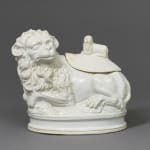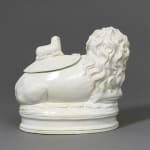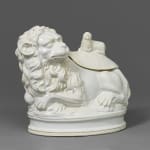


A Very Rare Alcora Faience Box and Cover Modelled as a Lion with Cub, Circa 1755-1800
Further images
A Very Rare Alcora Faience Box and Cover Modelled as a Lion with Cub, the tin glazed lion lies recumbent upon an oval base, its tail is whisked under its hindleg. The moulded lion looks back, ears perked, at its cub resting recumbent on its back. The cub forms the finial of the cover. Its flowing mane and furrowed facial features are accented with yellow tinged glaze.
Further Details: Forming the ‘fauna’ type, this form could have been used for dining purposes as a tureen. Alcora was founded by the ninth count of Aranda in 1727, producing largely tiles and tableswares in its early production. By the last quarter of the eighteenth century, naturalistic trompe l’oeil forms produced at Alcora were made by two modellers, Clemente Aicart (1765-ca. 1806) and Cristobal Mas (1770-1810). The lion form with cub is rare and is found in both the white, modelled after English creamware, or polychrome decorated.
Literature
See a similarly modelled example with polychrome decoration in Maria Dolors Giral, Loza y Porcelana de Alcora en El Museo de Cerámica de Barcelona (1998), pl. 220, pp. 106.
For a discussion of Alcora animals, see Anthony Ray, Spanish Pottery 1248-1898 (2000), p. 232.
See also Manuel Escrivá de Romani, Historia de la Ceramica de Alcora (1945), pl. 85 fig. 8 for a similar lion figure.
Join our mailing list
* denotes required fields
We will process the personal data you have supplied in accordance with our privacy policy (available on request). You can unsubscribe or change your preferences at any time by clicking the link in our emails.


